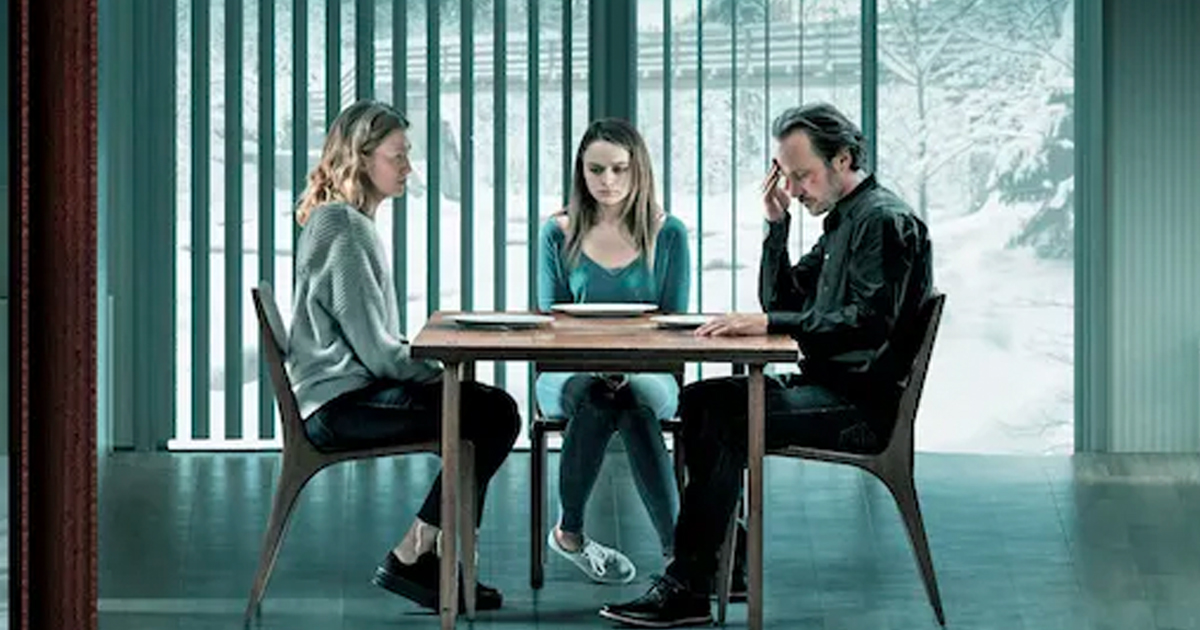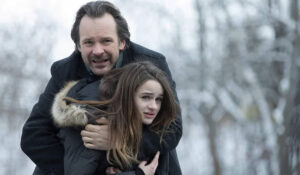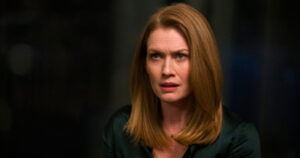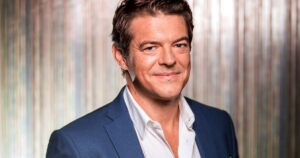
Welcome to the Blumhouse is an eight-film anthology horror series that is a collaboration between Amazon Studios and Blumhouse Television, a studio that knows a thing or two about producing horror films. The films will be released in blocks of four, with the first two films, Black Box, a medical horror-thriller starring Mamoudou Athie and The Lie, about two parents that will go to any length to help their daughter cover up a tragic accident, being released on Amazon Prime Video on Tuesday, October 6. Nocturne, starring Sydney Sweeney as a gifted music student, and Evil Eye, starring Sarita Choudhury as a mother obsessed with her daughter’s new boyfriend, will be released on Tuesday, October 13. The four remaining films will debut in 2021.

The Lie is a remake of a 2015 German film called We Monsters. It is directed by first time director Veena Sud, who has had great success creating, producing and show running series such as The Killing and Hanna, and stars Peter Sarsgaard, Joey King and The Killing and Hanna star Mireille Enos. The film came together when producers Alix Madigan-Yorkin & Christopher Tricarico, who had been working for an independent studio, saw the original film at the 2015 Toronto International Film Festival. “We were really fascinated by it and the universal questions that it brings up,” says Madigan-Yorkin. “Veena was the first person that we that we approached to adapt it and then shortly after she turned in the draft.” Sud was happy to write the film, but she had other goals in mind. “I was very eager to write it I knew I wanted to try something new in my career and direct a feature,” says Sud. “It was lovely to ask and have Alix smile and say, ‘Absolutely.’” Sud found directing to be radically different from her previous experience. “They each have their own set of challenges, but directing is a completely new muscle for me, says Sud. “It was terrifying, but it became a joy once I was into the work.”
While Sud stayed pretty close to the original source material in her adaptation, she did find the need to make some notable changes. “In order for an adaptation to be successful, I believe there does need to be a world that you built from scratch,” says Sud. “I watched We Monsters so that I knew what the essence the other creator strove. I began to build in my world around it and my experiences and my feelings, otherwise it would just be transcription.” According to Madigan-Yorkin, the order of the narrative was modified slightly for greater impact. “The ending was given away much earlier on in the original story, she says. “It was just a different way of storytelling. I wouldn’t necessarily say it was isn’t effective in the German film, but it was just very different and your allegiances at that point kind of shift a little bit.” Sud also wanted to add an element to the story that was uniquely American. The Expanse’s Cas Anvar, who is of Iranian descent, was cast in the role of the father of the friend who is killed. Sud wanted to examine how a man of color would be treated in the situation presented in the film. “The criminal justice system often makes brown and black people the perpetrator when they are absolutely not the criminal,” says Sud. “The characters in the German film were all white. It’s an American story.”
In casting the leads, Sud knew exactly who she wanted for the roles from the beginning. Mireille Enos and Peter Sarsgaard appeared in a Season Three episode of The Killing together, and Sud felt the actors would be perfect to explore the experiences that the parents go through in the film. “We had an incredible episode toward the end of the season in which Peter’s character is on death row about to be executed, and Mireille’s character had put him there, but is now realizing now that she may have made a mistake,” says Sud. “The conversation that ensues is between a man who wants to die and a woman who does not want him to. At the end of that day, we were exhausted, and Mireille said to Peter, ‘Let’s do a love story next time.’”

Enos was more than happy to work with Sud again. “Veena wrote me first and said, ‘I’m sending you this script and I really hope you like it,” says Enos. “’Peter and I have been collaborating on it for a long time, he’s definitely attached, and we would love to make it with the three of us. I read it that night and I immediately wrote to her and said, ‘Yes please!’” Though Enos would be working with Sud in a different capacity than she had in the past, she found the experience extremely gratifying. “Veena and I had obviously worked together for years and were very comfortable with each other and both have a healthy respect for each other,” she says. “She’s incredible. I’ve never seen her work as a director, and she was just remarkable. Everything she touches she does with such grace and intelligence. I would do anything she asked me to do.” While Enos and Sarsgaard were offered their roles, Joey King came to the film through the casting process. “She’s such a phenomenal actor and she is completely lovely to work with,” says Madigan-Yorkin. ”She was just spellbinding so we got very lucky with her. Now she’s totally blowing up, which is exciting.”
Though it was Sud’s first time directing, she knew how she wanted to work with her actors. “It’s about the prep that goes into it before the day,“ says Sud. “That’s the important time. That’s the time that’s necessary to have, so on the day the artists can do their thing. So, with my actors, we had rehearsal time, but we just talked. We didn’t rehearse a script, we just talked about the things that the family is not saying in the script. They could start exploring in that space of rehearsal so by the time that we shot, they had lived it together.”
The Lie examines the choices made by parents desperately trying to cover for their daughter’s mistake, which those involved in making the film found relatable. “Obviously, we want only the best for our children and there’s something that provokes the question, ‘Would you do the same thing if you were faced with those choices?,’” says Madigan-Yorkin. “You can’t know what the human instinct would be ultimately, but I would like to think that the answer would be no that we wouldn’t make all of the same choices. I don’t think we can know until you’re there, but I think that there is potential for people to relate to the experience that these parents were going through.” “I think that’s the part of it that makes it a horror film, says Enos.“ As a parent, you ask yourself ‘What would I do the same or what would I do that’s different?’. The whole long film takes them down a journey which one would hope most people will make different choices but at least in the initial choices, I could absolutely relate.”

The film was shot in the dead of winter in Toronto, making the weather conditions less than ideal for filming. With many scenes taking place outdoors in sub-zero temperatures, safety for the cast and crew was paramount. Sarsgaard felt the brunt of the cold weather, as he had to film a scene that entailed going into an icy river. “The biggest issue was the cold, and the day that [Peter Sarsgaard] had to go to the river was a big concern because of the temperature,” says Sud. “Peter had cold work experience, so he knew how to handle himself, and we had an incredible stunt director who was very safety conscious, which was very very important for me.” As it turned out, the frigid water wasn’t the only safety concern on that day. “About 100 yards down from where we shot the scene there was a waterfall,” says Sud. “We had divers at the end, we had ropes, we had lines, we had an army of people to protect Peter. Everyone is moving at a different speed when it’s that cold.” Producer Madigan-Yorkin echoes Suds concern for safety. “Ultimately, your biggest concern is obviously the safety and the comfort of the people that you are working with,” she says. “It was more about the logistics of having warming stations for the talent making sure they weren’t in the water for so long because the cold was just so severe,” adds Tricarico. Enos, who had to have hot water put in her mouth to stop her teeth from chatting, found there was a benefit to acting in such extreme cold. “There is a scene in which I’m standing outside and I’m having a terribly uncomfortable conversation with the father of the girl that’s probably dead and I’m absolutely freezing,” says Enos. “It added layers of discomfort to our acting and the scene, which helps the story in the end.”
The man behind the Welcome to the Blumhouse project is Blumhouse founder and CEO, Jason Blum. Blum has been responsible for a plethora of recent horror hits, including Us, Paranormal Activity, The Purge, Happy Death Day and The Invisible Man. Blum received Academy Award nominations for Best Picture for the films Whiplash (for which our own Tom Curley took home a Sound Mixing Oscar), Get Out, and BlacKkKlansman. Jennifer Salke, Head of Amazon Studios, pitched Blum about doing an anthology series and they pretty quickly landed on Welcome to the Blumhouse together. “We had done an anthology series for Hulu called Into the Dark, and there were some things about it I liked about it and some things that I didn’t like about it,” says Blum. “I loved doing an anthology, but I was excited to take a second crack at it and to use what we learned doing it the first time around. The trick with the film anthology is how to make each film feel separate and unique and original, but to still make it feel that they are part of a series. We talked about a variety of ideas, like should they all be supernatural, but we weren’t into any of them. Then Jen came up with the idea that they should all be underrepresented filmmakers, and I thought that was a great cohesive thing to bring th,e eight movies together. After that, we were off to the races.”

Few production studios can draw interest in an anthology series based on their reputation alone, but Blum believes that can be chalked up to how they’ve done business over the last twenty years. “We have tried to go with where the wind blows, and we have tried to make movies based on what the audience wants,” says Blum. “We always try to make things that are low budget first of all, because I think when you’ve raised budgets, the idea of a singular mission gets watered down by a bunch of people and a bunch of different opinions, and I think ultimately that the movie or the show becomes less interesting. I think we have also always really focused on telling great stories because on the movie side we’re not spending that much money on the stories, so they can be original. If you’re doing a really expensive movie, it has to feel like these other three movies that came before it. But we do the opposite. We say to ourselves ‘Is it great, is it scary and does it feel new?’ If we can compare it to three other successful movies than I probably don’t want to make it. We don’t have a wall up, however. As different things happen in the world, we shift. Streaming has shifted how we feel about certain things, but we try to have that core tenet, which has resulted in a good run, I would say.”
That core tenet has largely entailed making moderately budgeted films, with the talent taking payment on the backend. However, that business model relies heavily on quality projects. “On the movie side, it helps if everyone involved in making the film only makes money if the film makes money,” says Blum. “The problem with studio movies is at the director and the producer are paid before production starts, so they don’t have to worry about it being a commercial success. They already got paid. So, for us, you don’t get paid unless it’s commercially successful. You’d be surprised how many less arguments there are.” While that’s the business model Blumhouse utilizes on the film side, on Blumhouse Television productions, everyone gets paid upfront just like the normal model. However, Blum thinks that they’ve been able to carry over the same mentality from the movie side to continue to make quality content. “I think we’re in the habit of thinking about things from a distributor’s point of view, and that we’re focused on making TV shows and movies that people want to see,” says Blum. “Not everything that we make connects to the audience, but a good amount does and that’s because we’ve pulled good habits out of how our movie business model works. I’m also not interested in making things that nobody sees. That’s not my goal. Some people don’t care, and I respect that some people say ‘I want to make this beautiful thing, I want to put it out in the world and if five people see it, that’s great and if five hundred people see it that’s great. I’m not one of those people. I like a lot of people to see what we do.”
Blum has found that there are creative advantages to producing projects like Welcome to the Blumhouse for streaming services like Amazon. “When you’re making a theatrical scary movie there are certain guard rails that you have to stay within, he says. “You’ve got to have a lot of real jump scares. The audience is not going to pay $15.00 to see a scary movie in a movie theater if they don’t jump a lot a handful of times. They’re going to be pissed. But when you make a scary movie for streaming you don’t have to do that. Theatrical scary movie audiences are much younger, but with a streaming audience, you have both younger people and older people, so that’s fun. It’s a whole different set of rules to consider when we’re making these movies. It keeps life interesting for me and for the rest of the people at the company.”

